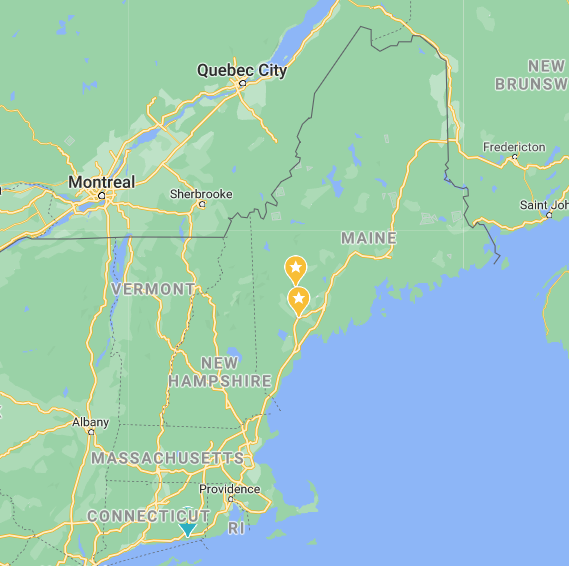Non Destructive Testing (NDT) Services
We are a Non-Destructive Testing (NDT) service provider serving Maine and New England, offering NDT inspection services as well as Level III NDT consulting. Our NDT inspections include ultrasonic weld inspection (UT-Weld), thickness testing (UTT), normal beam ultrasonic testing (UT), and Magnetic Particle Testing (MT). Our NDT Level III consulting services include NDT program development, NDT program oversight, and procedure development. Our NDT program is in accordance with ASNT CP-189, exceeding the recommendations of SNT-TC-1A. We have experience performing NDT to many standards and on many types of structures from dams, boats and bridges to planes, trains, and cranes, as well as boilers, storage tanks and copper pot stills. Please contact us today about your NDT requirements.
NDT inspection services are often used in quality control for ensuring compliance of welded connections, pinned connections, base metal thickness and component dimensions with industry codes and standards and customer specifications as well as for assessing in-service conditions such as remaining material thickness, the identification of fatigue cracks and welding discontinuities such as inclusions, incomlete penetration and lack of fusion. These inspections are commonly performed on the structural components such as pins, bolts, members, and welded connections in many types of structures. Whether you require weld inspection or thickness testing to API, ASME, AWS or ASTM Standards, you can count on us.
We provide these NDT and inspection services anywhere in the USA but can most readily serve Maine, New Hampshire, Vermont, Massachusetts, Connecticut, and Rhode Island.
Our Non Destructive Testing Procedures
Our personnel certification procedure is in accordance with ASNT Standard CP-189 “ASNT Standard for Qualification and Certification of Non-destructive Testing Personnel” and the AAR “Manual of Standards and Recommended Practices Section C-III Specification for Tank Cars” Appendix T. Our certifcation procedure exceeds the recommendations of ASNT Recommended Practice No. SNT-TC-1A. Our NDT program is managed by our in-house NDT Level III in the NDT method of Ultrasonic Testing (UT) and Magnetic Particle Testing (MT).
We use NDT examination procedures that are in accordance with applicable industry standards such as ASME V, AWS D1.1, D1.5, D1.6 and in accordance with customer specifications. For example: we frequently perform ultrasonic thickness testing (UTT) in accordance with ASTM E797 at the locations specified by the customer (extent of examination). Other customer specification commonly involve requirments around techniques, surface preperation, timing, reporting, and reexamination. We're able to conduct NDT examinations in accordance with many industry standards, so please contact us about your NDT requirments.
Our Nondestructive Testing (NDT) Services
Description of NDT Services
Ultrasonic Thickness Testing (UTT)
Ultrasonic Thickness Testing or UTT is an ultrasonic testing technique which is used to measure material thickness. This technique is often used when corrosion is suspected on an in-service component such as a steel floor, boat / ship hull, steel tank wall, copper still wall, or structural framing such as what is found in bridge or building construction. UTT is also used to evaluate such components in new construction to ensure proper thickness of the part in accordance with the construction specifications. This technique requires access from only one side of the part under examination. The testing surface must be made smooth so that it is free of loose paint, rust, and dirt. A smooth testing surface ensures that the ultrasonic energy can be efficiently transmitted into the test part. Ultrasonic thickness testing can usually be performed through surface coatings such as paint or an epoxy liner as long as the coating is not too thick and is tightly bonded and adhered well to the base material. We use a technique called gate one minus gate two, meaning that material thickness is determined by measuring the distance between two backwall reflections which ensures the most accurate measurement. We calibrate our flaw detectors on a block of similar material to the test piece and of a known thickness so that measurements are made accurately.


Ultrasonic Straight Beam Testing (UT)
Ultrasonic Straight Beam Testing or Normal Beam Testing is an ultrasonic testing technique which is used to inspect base material such as bridge pins, bolts, structural framing, and raw products for geometric conformance and for defects such as delamination's, cracks, corrosion, laps, hot tears, and many other types of possible discontinuities. This technique requires access from only one side of the part under examination however depending on the geometry of the part, it is often desirable to inspect from both sides. The testing surface must be made smooth so that it is free of loose paint, rust, and dirt. A smooth testing surface ensures that the ultrasonic energy can be efficiently transmitted into the test part. Ultrasonic Straight Beam Testing can usually be performed through surface coatings such as paint or an epoxy liner as long as the coating is not too thick and is tightly bonded and adhered well to the base material. We calibrate our flaw detectors on a block of similar material to the test piece and containing defects with known characteristics so that any reflectors that are observed within the part can be characterized and sized accurately.



Ultrasonic Weld Inspection (UT)
Ultrasonic Weld Inspection or Shear Wave Testing is an ultrasonic testing technique which is used to inspect welds and the surrounding Heat Affected Zone (HAZ) for defects such as lack of fusion, inadequate joint penetration, porosity, inclusions, and cracks. Weld inspection is often used for testing of welds in pipe, sheet, structural framing, including the welded connections in buildings, ships, railroad tank cars, rail line, dams, bridges, bridge piles, construction equipment, and amusement park rides, as well as many other types of structures. The testing surface must be made smooth so that it is free of loose paint, rust, and dirt. A clean and smooth testing surface ensures that the ultrasonic energy can be effectively transmitted into the test part. Ultrasonic weld inspection can usually be performed through surface coatings such as paint or an epoxy liner as long as the coating is tightly bonded and adhered well to the base material. We calibrate our flaw detectors on a block of similar material to the test piece and containing defects with known characteristics so that any reflectors that are observed in the weld can be characterized and sized accurately.



Magnetic Particle Testing (MPT)
Magnetic Particle Testing (MPT) is a nondestructive testing method which is used to inspect ferromagnetic materials for surface breaking cracks, laps and seams as well as slightly sub surface discontinuities such as lack of fusion or porosity. It is an aided visual method where the inspector observes the part and uses colorful magnetic particles to bring out any defects and make them more easily seen. There are dry visable, wet visable and wet fluorescent techniques for this method. Once the test part is magnetized, colorful iron filing, either dry or suspended inliquid - called magnetic particles are lightly blown or sprayed across the inspection area. When there is a surface breaking or slightly subsurface defect, it produces magnetic leakage which produces a stronger magnetic field than the area around it, thus attracting the magnetic particles and creating an indication which can easily be observed. This method requires that the test surface be free of loose scale, dirt, and paint. Frequently used for inspecting welds, damaged or ageing bridge components, pressure vessels and other structures where cracks may propegate and cause unsafe conditions.
NDT Level III Services
NDT personnel certifcation standards such as CP-189, SNT-TC-1A, and those included in the AAR Manual of Standards and Reccomended Practices (MSRP) require / reccomend that an NDT Level III oversee some aspects of an NDT program admisnistered by an employer. These aspects include The administartion of exams for personnel to qualify for NDT certification and the certifcation of such personnel who successfully complete the requirments of an employers written practice. The Written practice is the document which outlines the employer's requirments for education, training, examination, and certification of personnel and should be based on the appropriate industry standard. An NDT level III can prepare this document and the employers Certifying Authority can accept it as the employers procedure for certification of their NDT personnel. Similarly, an NDT Level III should approve any NDT procedures that will be ued by NDT pesonnel for NDT inspections. NDT Level III services are those that aid the employer in getting a written practice in place, getting NDT personnel trained and certified to do work, and providing procedures and instruction for use in the conduct of NDT.
Common NDT phrases
A variety of phrases can be used to describe these NDT services. They include NDT Level III Services, NDT Level 3 Services, NDT Procedure Preperation, UT examination, UT inspection, UT Testing, NDT examination, NDT inspection, NDT inspector, UTT examination, UTT inspection, Ultrasonic thickness testing, ultrasonic examination, ultrasonic inspection, ultrasonic testing, ultrasonic weld inspection, weld inspection, weld testing, shear wave testing, angle beam testing, normal beam testing, ultrasonic weld testing, Magnetic Particle Testing, MPT, MT, Wet fluorescent magnetic particle, and dry MT. These services are offered in Maine, New Hampshire, Vermont, Massachusetts, Connecticut, and Rhode Island.
Our NDT Service Area
We perform non destructive testing all across the United States (USA) so wherever you are located, please feel free to contact us. We can most readily serve the New England States. We provide NDT services including ultrasonic thickness testing, ultrasonic straight beam testing, ultrasonic weld inspection, magnetic particle testing, and Level III NDT Services in Maine, New Hampshire, Vermont, Massachusetts, Connecticut, and Rhode Island. Please contact us about your NDT requirments.





































